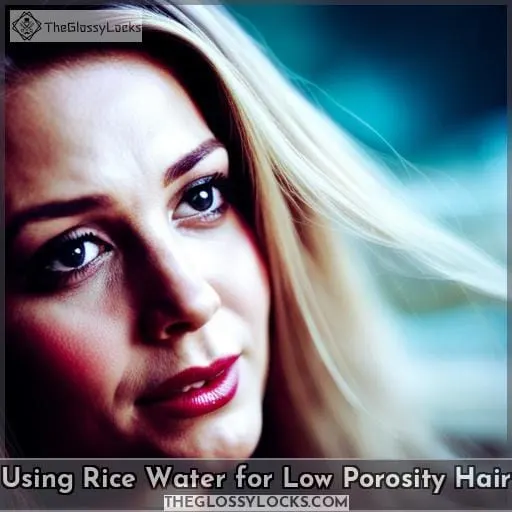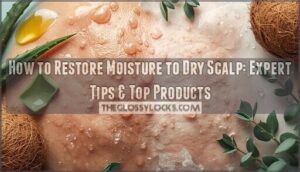This site is supported by our readers. We may earn a commission, at no cost to you, if you purchase through links.

If you’ve been on a quest for hair liberation and want to understand the key to enhancing your locks, you’re in the right place. Low porosity hair, often a mystery to many, requires a tailored approach, and rice water could be the game-changer you’ve been seeking.
This natural remedy has a historical legacy that spans centuries, with the Japanese and Chinese attributing their long, lustrous hair to it.
Rice water, enriched with proteins, has the potential to strengthen your hair by addressing its unique needs. In this exploration, we’ll dive into the do’s and don’ts of using rice water for low porosity hair, alongside tips for taking exceptional care of your locks.
Embrace the knowledge that will empower you to make the most of this age-old remedy and unlock the beauty and strength of your low porosity hair. Get ready to embark on a journey to discover the historical significance and the true impact of rice water on your cherished locks.
Table Of Contents
- Key Takeaways
- Using Rice Water for Low Porosity Hair
- Do’s and Don’ts of Using Rice Water on Low Porosity Hair
- Tips for Taking Care of Low Porosity Hair
- The Historical Significance of Rice Water
- Rice Water’s Impact on Low Porosity Hair
- Potential Downsides of Using Rice Water
- Preventing Side Effects When Using Rice Water
- Optimizing Rice Water Use: to Ferment or Not to Ferment?
- Frequently Asked Questions (FAQs)
- How long does rice water last in the fridge? Properly stored rice water can last 3-5 days refrigerated. However, it’s best to use freshly made rice water for optimal results.
- Can I use rice water if I’m allergic to rice? Those with rice allergies should avoid using rice water, as it contains proteins that can trigger allergic reactions. Opt for other protein treatments instead.
- Conclusion
Key Takeaways
- Rice water can provide protein benefits for strengthening low porosity hair if used properly.
- The proper technique is crucial. Soak rice in water, apply the rice water to hair for 15-20 minutes at most, and rinse thoroughly.
- Avoid overusing rice water, as it can cause dryness or irritation in low porosity hair.
- Protect hair while sleeping by using a silk or satin bonnet after the rice water treatment.
Using Rice Water for Low Porosity Hair
When considering the use of rice water for low porosity hair, it’s crucial to understand the proper techniques and frequency for optimal results. To harness the benefits of rice water effectively, you’ll need to gather your materials, follow specific instructions for application, and carefully consider how often it should be incorporated into your low porosity hair care routine.
Gather Your Materials
Get ready to assemble what you need for this treatment. Like a chef preparing a fine dish, you’ll want to have your ingredients and tools ready. When selecting materials for your rice water hair treatment, ensure you have rice, water, and an essential oil on hand.
These basic ingredients are the foundation for an effective application. Remember, historical traditions, such as those of Yao women, highlight the significance of preparation in this hair health ritual.
Be mindful of avoiding overuse by limiting your rice water treatments to maintain the moisture balance in your low porosity hair.
Instructions for Using Rice Water on Low Porosity Hair
To effectively treat your low porosity hair, start by rinsing half a cup of rice and soaking it in water.
Here are three essential instructions for using rice water to maintain the moisture balance and improve hair elasticity:
- After soaking, strain the rice and add your choice of essential oil to enhance the treatment’s benefits.
- Apply the rice water to your hair, ensuring it’s evenly distributed. Cover it with a shower cap for 15-20 minutes.
- Rinse your hair thoroughly. Follow up with a suitable shampoo, conditioner, and leave-in conditioner.
How Often Should You Use Rice Water With Low Porosity Hair?
Maintaining the balance is essential – how often should you apply rice water for your low porosity hair? Finding the sweet spot is crucial. Too often, and you risk protein overload, leading to dry, brittle hair. Too seldom, and you might not enjoy the benefits of improved hair elasticity.
Generally, it’s recommended to limit your organic rice water treatment to once a month. This way, you strike a balance between strengthening your hair and retaining its moisture, ensuring the best results for low porosity care.
Do’s and Don’ts of Using Rice Water on Low Porosity Hair
When caring for your low porosity hair with rice water treatments, it’s crucial to understand the dos and don’ts to achieve the best results. Proper application and maintenance can make all the difference in harnessing the benefits of rice water for your unique hair needs.
Do’s
Explore the essential recommendations to make the most of this treatment and keep your locks healthy and vibrant. Using heat during rice water application can aid its penetration, especially for low porosity hair.
Incorporating clarifying treatments into your routine once or twice a month ensures your hair remains free of product buildup. Don’t forget to protect your hair with a silk bonnet, preserving moisture while you sleep.
Understanding the historical significance and impact of rice water on low porosity hair is crucial for successful results.
Don’ts
Avoid leaving the treatment in for more than 20 minutes, as it could result in undesirable outcomes. Overexposure to rice water can cause protein overload, leaving your low porosity hair dry and brittle.
Another mistake to avoid is combining rice water with other protein-rich products; this will upset the balance. Also, refrain from using heavy products or oils that may lead to buildup; instead, choose lightweight hair oils that won’t weigh down your hair.
Lastly, always remember to protect your hair with silk bonnets to retain moisture and prevent damage.
Tips for Taking Care of Low Porosity Hair
To effectively care for your low porosity hair, it’s crucial to incorporate expert strategies into your routine. First, when deep conditioning your locks, ensure you use heat, as it aids in product penetration and moisture retention.
Additionally, remember to schedule regular clarifying treatments to prevent product buildup, and make sure you sleep with a silk or satin bonnet to protect your hair and retain that much-needed moisture.
Use Heat When You Deep Condition Your Locks
Enhance your deep conditioning routine by incorporating heat to ensure that your locks receive the full benefits of the treatment. Heat conditioning is essential for low porosity hair as it helps open up the cuticles, allowing moisture to penetrate effectively.
Using a shower cap and a warm towel or a steamer can maximize the moisture balance in your hair. Just remember, moderation is key, as excessive heat can lead to protein overload. Finish with a silk bonnet to retain moisture and protect your locks. Don’t forget occasional clarifying treatments to maintain healthy, low porosity hair.
Use Regular Clarifying Treatments
To effectively care for your less porous locks, incorporate regular clarifying treatments into your hair care routine. These treatments are crucial for maintaining moisture balance and ensuring that your hair doesn’t suffer from protein overload, especially if you use rice water.
Remove Buildup: Clarifying treatments help eliminate product buildup that can weigh down low porosity hair.
Boost Hair Elasticity: Enhancing hair elasticity makes your locks more manageable.
Prepare for Moisture: Clearing away residue allows your hair to better absorb moisturizing hair care products, combating dryness and damage.
Make sure to integrate these clarifying treatments into your hair care regimen for healthier, stronger low porosity hair.
Sleep With a Silk or Satin Bonnet
Protect your precious locks while you slumber by embracing the soft embrace of a silk or satin bonnet, ensuring your hair retains its moisture and shine.
| Benefits | Maintenance | Silk vs. Satin | Hair Protection |
|---|---|---|---|
| Reduces Friction | Easy to Wash | Silk: Luxurious Feel | Overnight Care |
| Prevents Breakage | Air Dry or Low Heat Dry | Satin: Affordable | Maintains Shine |
| Retains Moisture | Durable Material | Smooth on Hair | Prevents Split Ends |
| Gentle on Hair | Store in a Clean Pouch | Less Absorbent | Ultimate Hair Care |
For low porosity hair, this is the secret to waking up with a silky, hydrated mane. Whether it’s silk or satin, both offer fantastic benefits, but silk epitomizes luxury. These bonnets reduce friction, preventing breakage and split ends. Maintenance is a breeze – wash and air dry or use low heat.
Embrace the power of silk or satin for your hair’s liberation and ultimate health.
The Historical Significance of Rice Water
Rice water has rich historical and cultural roots in rituals of Chinese and Japanese cultures that have long embraced it as a natural hair treatment. For generations, these cultures have recognized rice water’s remarkable benefits.
Brimming with amino acids, minerals, vitamins, and inositol, rice water played a pivotal role in promoting long, healthy hair in the past. Its properties restored hair elasticity, imbued it with softness and shine, reduced tangles, targeted split ends and damage.
This tradition is particularly significant in its association with the Yao women, who’ve entrusted rice water with their hair care for decades. Their meticulous preparation, hand-washing rice, shows the patience and understanding needed to harness this tradition’s full potential.
For those with low porosity hair, though, it’s crucial to tread cautiously, as excess protein can lead to brittle, dull hair.
Understanding rice water’s historical significance and traditions can help unlock its potential while maintaining hair health.
Rice Water’s Impact on Low Porosity Hair
Your low porosity hair naturally lacks moisture. Though rice water provides protein to strengthen strands, overuse causes protein overload. This leads to brittle, lackluster locks. Limit rice water to once a month, applying to damp hair for 15 minutes before rinsing thoroughly.
Follow with a hydrating conditioner. Ferment the rice water for added vitamins B and fatty acids, which enhance hair health.
Clarify monthly to prevent product buildup. Sleep in a satin bonnet and deep condition weekly.
Remember – balance is key. Rice water strengthens, but moisture is the lifeblood of your coils.
Potential Downsides of Using Rice Water
Despite its perks, overdoing that liquid gold can leave your tresses parched.
Rice water seems like a miracle elixir for hair, but it can actually damage your locks if used incorrectly.
- Protein overload – Too much protein from rice water can make low porosity hair brittle.
- Dryness – Rice water’s starchy composition can strip moisture from your strands.
- Breakage – Overuse causes brittleness and split ends. Let your hair’s reaction guide frequency.
- Dullness – Excess protein causes limp, lackluster hair lacking shine.
- Irritation – Fermented rice water can irritate sensitive scalps. Do a patch test first.
While rice water offers benefits, carefully balance its use based on your hair’s needs. Too much protein causes as many problems as too little when it comes to your crown’s glory.
Preventing Side Effects When Using Rice Water
For people with low porosity hair, it’s important to gradually introduce rice water and closely monitor for any negative effects. A good approach is to initially leave the rice water treatment on for only 10-15 minutes once per week.
After that, reduce frequency of use or discontinue altogether if your hair becomes excessively dry or brittle. Varying the rice water contact time and application schedule allows you to find the sweet spot that provides benefits without causing damage.
Paying close attention and making small adjustments prevents overuse that could compromise the integrity of low porosity strands.
Start Slow
Testing rice water on a small section of hair first allows you to gauge its effects before fully committing. Focus on your roots and mid-lengths, massaging rice water into the hair for 2-3 minutes. Rinse thoroughly before proceeding with shampoo and conditioner. Monitor for any dryness or breakage over the next few days.
If all seems well, gradually increase the application time and area covered. With patience and care, you can unlock rice water’s benefits while maintaining your hair’s moisture balance.
Scale Back if Needed
Though challenging at first, scaling back use allows your tresses to breathe easily again. Your mane demands balance – too much rice water tips the scales. Listen when she cries for moisture with frizz and tangles.
Find the sweet spot through patience. Adjust as needed, even taking breaks, so those precious strands sing with newfound elasticity once more.
Watch Your Time
Your locks long for balance. Watch the clock when using rice water. Limit treatments to 20 minutes maximum. This prevents overprocessing, which leads to dry, brittle strands. Honor time-tested traditions passed down over generations.
Be patient, not hasty. Nurture your hair slowly. Listen to it. Heed its needs. Together you will reveal its true, radiant nature.
Optimizing Rice Water Use: to Ferment or Not to Ferment?
Baking up some fluffy goodness with that rice juice can really breathe new life into your hair, but times like these call for getting creative. Let it sit for a while or spin in some botanical boosters, so your strands can soak up all them vitamins and proteins without getting parched and brittle.
Fermenting your rice water adds extra nourishment for your locks by breaking down them proteins into smaller bits your hair can absorb real well. But too much protein makes hair dry and straw-like, so balance it out with moisture-rich conditioners and oils.
Like the Yao women did, fermenting for a few days draws out nutrients while keeping things mild. Fuse old traditions with new ideas like adding aloe or coconut oil into your rice water recipe. This way your mane gets the strengthening it needs without losing its silky, hydrated feel.
Frequently Asked Questions (FAQs)
How long does rice water last in the fridge? Properly stored rice water can last 3-5 days refrigerated. However, it’s best to use freshly made rice water for optimal results.
Refrigerate your freshly made rice water for 3-5 days at most. Beyond that timeframe, it’ll start growing bacteria, potentially damaging your hair. I recommend using it promptly for the best results, or freeze 1-2 cup portions to extend its shelf life up to 6 months.
Can I use rice water if I’m allergic to rice? Those with rice allergies should avoid using rice water, as it contains proteins that can trigger allergic reactions. Opt for other protein treatments instead.
You should avoid rice water if you are allergic to rice. The proteins in rice water can trigger allergic reactions.
Conclusion
Taking care of low porosity hair can feel like climbing a mountain at times. However, with patience and the right techniques, you can nourish those strands. Rice water, used properly, is one tool that may provide the nourishment your hair craves.
Try incorporating heat, clarifying treatments, and protecting your hair while sleeping to show it some TLC.











